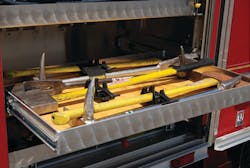In last month’s installment of Innovative Rigs on the Street, we featured a new Sutphen pumper built for the Fuller Road Fire Department in the Town of Colonie, NY. Over the years, the town’s 12 fire departments have worked together on a number of initiatives, including a phantom box-alarm system, joint training programs and automatic-aid dispatching. Several fire companies on the south side of Colonie worked together to provide apparatus and staffing resources that would provide for the response of specifically designated units for structural fires and other incidents.
Like many departments, over a period of years each station’s apparatus fleet seemed to grow in size to include multiple pieces of engine, ladder and rescue apparatus. Careful analysis of each fire company’s fleet included a review of the acquisition costs, insurance, maintenance and other operational considerations. The result was that two of the stations agreed to give up their stand alone rescue units in exchange for another company reducing the size of its fleet by the removal of a ladder truck. The alarm assignments were then altered to provide for the automatic response of the closest available ladder and rescue unit to alarms, which would also ensure adequate staffing for the responding apparatus. After many years of operations, this program has proven to be beneficial to the respective departments and has sharpened the training requirements for fire company members.
The Fuller Road Fire Department, organized in October 1926, placed its first ladder company into service in 1972 with the delivery of Sutphen 85-foot aerial tower. Equipped with a heavy compliment of ground ladders, Truck 3 served the department until 1991 when it was replaced with a second Sutphen tower. The second version was equipped with many features that could not have been conceived of some 20 years earlier with a four-door, such as a climate-controlled cab, electronic interlocks and enhanced warning lights. As Truck 3 protects its first-due area, the unit also regularly responds to incidents with the Colonie Village, Midway, Shaker Road-Loudonville and West Albany fire companies.
The latest aerial device to serve the Fuller Road Fire Department was placed into service during 2009 with the delivery of a new Sutphen SPH-100 mid-mount tower. The department worked closely with Sutphen representative Phil Vander Molen to refine the design for the apparatus, which incorporates a fire pump, water tank and a compliment of ground ladders, in addition to an extensive array of hand tools and equipment.
Truck 3 is built on a wheelbase of 236 inches with an overall length of 46 feet, 4 inches. The overall height on the units is 11 feet, 6 inches to the top of the tower handrails. The aluminum cab provides seating for eight personnel with five seats equipped with self-contained breathing apparatus (SCBAs). For enhanced safety a Firecom headset intercom is provided, together with Zico back-up lights located in the rear fender panels and Britax cornering lights mounted at the back body corner on each side. All running and warning lights are LED style to reduce the electrical load on the apparatus.
The apparatus is equipped with a Meritor MFS front axle rated at 22,000 pounds together with a 48,000-pound rated rear axle equipped with Raydan air-ride suspension. Braking is provided by S-cam brakes on the front and rear, together with a Jacobs engine brake for auxiliary braking capability. The engine is powered by a Cummins ISM engine rated at 500 horsepower with an Allison EVS-4000 automatic transmission. The chassis exhaust system was designed to adapt to a Plymovent system installed in the fire station.
The cab measures 62 inches from the centerline of the front axle to the back of the cab to minimize the impact on wheelbase and overall length. While a number of cab heights were available, the department chose a flat-roof cab design so as to not reduce the tower capabilities when operating over the front of the apparatus. The tower has a rated height of 100 feet at an 80-degree elevation with a horizontal reach of 89 feet. With the tower waterway rated at 2,000 gpm, the platform can safely support a 500-pound load when flowing water and 1,000 pounds when dry. Akron model 3473 monitors are provided in the platform, together with two 2.5-inch gated outlets and an under platform water curtain.
The fire pump is a Hale QMax single stage rated at 2,000 gpm with all stainless steel piping. Each of the side suction is provided with a Hale MIV intake valve with auxiliary 2.5-inch inlet provided on each side of the apparatus. Discharges include two 2-inch and one 2.5-inch crosslay beds for preconnected handlines. Two 2.5-inch discharges are provided at the left side panel with one 2.5-inch and one 3-inch LDH discharge on the right side. A 4-inch discharge is provided to supply the tower waterway. All intakes and discharges are equipped with Akron electric valves with flow meters provided on each discharge.
The stainless steel body has 12 enclosed body compartments equipped with a combination of hinged and painted Robinson roll-up shutter doors. The 300-gallon water tank provides initial supply for the three preconnected attack lines with a hose bed carrying 900 feet of 5-inch supply line. A total of 156 feet of aluminum ground ladders are carried both inside the body at the rear and on top of the right side body compartments, including 24-, 28- and 35-foot extension ladders as well as several 16-foot roof ladders, a 10-foot folding ladder and a 13-foot Little Giant ladder.
An Onan 15.0 Kw hydraulic generator supplies power to four Fire Research Optimum 1,000-watt lights mounted on the cab and body and three Fire Research 750-watt lights on the platform. Other 120-volt equipment includes two Hannay electric cable reel and several cab-mounted outlets. Other scene lights include two Whelen 900 LEDs mounted below the crew cab windows with additional LEDs provided at the rear body and the platform.
The warning light package consists of a Whelen Freedom LED light bar on the cab roof with two Whelen LED 24-inch long light bars facing the side. Whelen 600 Super LED lights are located around the apparatus, with Whelen micro bar lights mounted at the rear body corners.
The compartments were designed to accommodate a variety of equipment including four saws, four smoke ejectors, forcible entry tools, spare cylinders, extinguishers, rope bags, standpipe packs and salvage equipment. Using a combination of adjustable shelves, slide trays, modules and tool boards, all equipment was located and mounted for ready access.
The overall design and layout of Truck 3 was the result of many hours of planning and review to arrive at a successful conclusion. The Fuller Road Fire Department had the advantage of having some 37 years of experience in operating with a mid-mount aerial tower and used their lessons well in developing the third generation of aerial device to serve and meet the needs of the community.
Appreciation is extended to the members of the Fuller Road Fire Department and Mr. Phil Vander Molen who provided information for this article.
TOM SHAND is a 37-year veteran of the fire service having served with departments in Maryland, Pennsylvania and New York. He has worked in the fire apparatus industry since 1985, including 15 years with Saulsbury Fire Apparatus. He is a contributing editor to Fire Apparatus Journal and Firehouse Magazine and works with Mike Wilbur at Emergency Vehicle Response. He co-hosts the Apparatus Architects podcast with Wilbur, based on their column in Firehouse Magazine.
About the Author

Tom Shand
TOM SHAND, who is a Firehouse contributing editor, is a 36-year veteran of the fire service. He works with Michael Wilbur at Emergency Vehicle Response, consulting on a variety of fire apparatus and fire department master-planning issues. Shand is a member of the Firehouse Hall of Fame.
